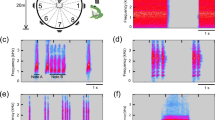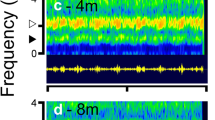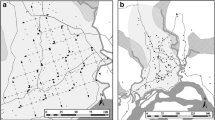Abstract
Frogs and toads commonly form large choruses around suitable breeding habitat during the mating season. Although often regarded as a constraint on the acoustic behavior of signalers and receivers, the sounds of a chorus could also serve as an acoustic beacon that allows some frogs to locate the breeding aggregation. Attraction to chorus sounds might be particularly important for explosively breeding frogs. In these species, which often mate just one or a few days during the year, the timing and location of breeding aggregations can be unpredictable because their formation often depends on local climatic factors, such as rainfall or a change in temperature. I used laboratory playback experiments to test the hypothesis that male wood frogs (Rana sylvatica), an explosively breeding frog, exhibit positive phonotaxis toward the sound of a conspecific chorus. Males were released at the center of a rectangular arena with a speaker positioned in each corner facing toward the release point. In a single-stimulus experiment, more males approached a speaker broadcasting a conspecific chorus than the three silent speakers in the arena. In a two-stimulus experiment, more males approached a speaker broadcasting a conspecific chorus compared to the two silent speakers or a fourth speaker simultaneously broadcasting the spectrally overlapping sound of a heterospecific (R. septentrionalis) chorus. These results are consistent with the hypothesis that male wood frogs could use the sound of a chorus as a beacon to locate a short-lived breeding aggregation.




Similar content being viewed by others
References
Amézquita A, Castellanos L, Hodl W (2005) Auditory matching of male Epipedobates femoralis (Anura: Dendrobatidae) under field conditions. Anim Behav 70:1377–1386
Bee MA, Gerhardt HC (2001a) Habituation as a mechanism of reduced aggression between neighboring territorial male bullfrogs (Rana catesbeiana). J Comp Psychol 115:68–82
Bee MA, Gerhardt HC (2001b) Neighbour–stranger discrimination by territorial male bullfrogs (Rana catesbeiana): I. Acoustic basis. Anim Behav 62:1129–1140
Bee MA, Gerhardt HC (2001c) Neighbour–stranger discrimination by territorial male bullfrogs (Rana catesbeiana): II. Perceptual basis. Anim Behav 62:1141–1150
Bee MA, Gerhardt HC (2002) Individual voice recognition in a territorial frog (Rana catesbeiana). Proc R Soc Lond B Biol Sci 269:1443–1448
Bee MA, Perrill SA, Owen PC (1999) Size assessment in simulated territorial encounters between male green frogs (Rana clamitans). Behav Ecol Sociobiol 45:177–184
Bee MA, Perrill SA, Owen PC (2000) Male green frogs lower the pitch of acoustic signals in defense of territories: a possible dishonest signal of size? Behav Ecol 11:169–177
Berven KA (1981) Mate choice in the wood frog, Rana sylvatica. Evolution 35:707–722
Boatright-Horowitz SS, Cheney CA, Simmons AM (1999) Atmospheric and underwater propagation of bullfrog vocalizations. Bioacoustics 9:257–280
Bogert CM (1960) The influence of sounds on the behavior of amphibians and reptiles. In: Lanyon WE, Tavolga WN (eds) Animal sounds and communication. American Institute of Biological Sciences, Washington, DC, pp 137–320
Bourne GR, Collins AC, Holder AM, McCarthy CL (2001) Vocal communication and reproductive behavior of the frog Colostethus beebei in Guyana. J Herpetol 35:272–281
Brenowitz EA (1989) Neighbor call amplitude influences aggressive behavior and intermale spacing in choruses of the Pacific treefrog (Hyla regilla). Ethology 83:69–79
Brooke PN, Alford RA, Schwarzkopf L (2000) Environmental and social factors influence chorusing behaviour in a tropical frog: examining various temporal and spatial scales. Behav Ecol Sociobiol 49:79–87
Bush SL, Dyson ML, Halliday TR (1996) Selective phonotaxis by males in the Majorcan midwife toad. Proc R Soc Lond B Biol Sci 263:913–917
Caldwell JP (1997) Pair bonding in spotted poison frogs. Nature 385:211
Capranica RR, Moffat JM (1983) Neurobehavioral correlates of sound communication in anurans. In: Ewert JP, Capranica RR, Ingle DJ (eds) Advances in vertebrate neuroethology. Plenum, New York
Davies NB, Halliday TR (1978) Deep croaks and fighting assessment in toads Bufo bufo. Nature 274:683–685
Davis MS (1987) Acoustically mediated neighbor recognition in the North American bullfrog, Rana catesbeiana. Behav Ecol Sociobiol 21:185–190
Diego-Rasilla FJ, Luengo RM (2004) Heterospecific call recognition and phonotaxis in the orientation behavior of the marbled newt, Triturus marmoratus. Behav Ecol Sociobiol 55:556–560
Elliott L (2004) The calls of frogs and toads. Stackpole, Mechanicsburg, PA
Friedl TWP, Klump GM (2002) The vocal behaviour of male European treefrogs (Hyla arborea): implications for inter- and intrasexual selection. Behaviour 139:113–136
Gerhardt HC (1975) Sound pressure levels and radiation patterns of vocalizations of some North American frogs and toads. J Comp Physiol 102:1–12
Gerhardt HC (1995) Phonotaxis in female frogs and toads: execution and design of experiments. In: Klump GM, Dooling RJ, Fay RR, Stebbins WC (eds) Methods in comparative psychoacoustics. Birkhäuser Verlag, Basel, pp 209–220
Gerhardt HC (2001) Acoustic communication in two groups of closely related treefrogs. In: Advances in the study of behavior, vol 30, pp 99–167
Gerhardt HC, Bee MA (2006) Recognition and localization of acoustic signals. In: Narins PM, Feng AS, Fay RR, Popper AN (eds) Hearing and sound communication in amphibians, vol 28. Springer, Berlin Heidelberg New York, pp 113–146
Gerhardt HC, Huber F (2002) Acoustic communication in insects and anurans: common problems and diverse solutions. Chicago University Press, Chicago
Gerhardt HC, Klump GM (1988a) Masking of acoustic signals by the chorus background noise in the green treefrog: a limitation on mate choice. Anim Behav 36:1247–1249
Gerhardt HC, Klump GM (1988b) Phonotactic responses and selectivity of barking treefrogs (Hyla gratiosa) to chorus sounds. J Comp Physiol A 163:795–802
Grafe TU (1997) Costs and benefits of mate choice in the lek-breeding reed frog, Hyperolius marmoratus. Anim Behav 53:1103–1117
Hauselberger KF, Alford RA (2005) Effects of season and weather on calling in the Australian microhylid frogs Austrochaperina robusta and Cophixalus ornatus. Herpetologica 61:349–363
Henzi SP, Dyson ML, Piper SE, Passmore NE, Bishop P (1995) Chorus attendance by male and female painted reed frogs (Hyperolius marmoratus): Environmental factors and selection pressures. Funct Ecol 9:485–491
Howard RD (1978) Evolution of mating strategies in bullfrogs, Rana catesbeiana. Evolution 32:850–871
Howard RD (1980) Mating behavior and mating success in wood frogs, Rana sylvatica. Anim Behav 28:705–716
Howard RD, Kluge AG (1985) Proximate mechanisms of sexual selection in wood frogs. Evolution 39:260–277
Howard RD, Palmer JG (1995) Female choice in Bufo americanus: Effects of dominant frequency and call order. Copeia 212–217
Howard RD, Young JR (1998) Individual variation in male vocal traits and female mating preferences in Bufo americanus. Animal Behaviour 55:1165–1179
Kroodsma DE (1989) Suggested experimental designs for song playbacks. Anim Behav 37:600–609
Loftus-Hills JJ, Littlejohn MJ (1971) Mating-call sound intensities of anuran amphibians. J Acoust Soc Am 49:1327–1329
Marshall VT, Humfeld SC, Bee MA (2003) Plasticity of aggressive signalling and its evolution in male spring peepers, Pseudacris crucifer. Anim Behav 65:1223–1234
Martof BS, Humphries RL (1959) Geographic variation in the woodfrog, Rana sylvatica. Am Midl Nat 61:350–389
Murphy CG (2003) The cause of correlations between nightly numbers of male and female barking treefrogs (Hyla gratiosa) attending choruses. Behav Ecol 14:274–281
Murphy CG, Gerhardt HC (2002) Mate sampling by female barking treefrogs (Hyla gratiosa). Behav Ecol 13:472–480
Narins PM (1982) Effects of masking noise on evoked calling in the Puerto Rican coqui (Anura, Leptodactylidae). J Comp Physiol 147:439–446
Narins PM, Hodl W, Grabul DS (2003) Bimodal signal requisite for agonistic behavior in a dart-poison frog, Epipedobates femoralis. Proc Natl Acad Sci USA 100:577–580
Oldfield B, Moriarty JJ (1994) Amphibians and reptiles native to Minnesota. University of Minnesota Press, Minneapolis
Oldham RS (1966) Spring movements in the American toad, Bufo americanus. Can J Zool 44:63–100
Oldham RS (1967) Orienting mechanisms of the green frog, Rana clamitans. Ecology 48:477–491
Oseen KL, Wassersug RJ (2002) Environmental factors influencing calling in sympatric anurans. Oecologia 133:616–625
Penna M, Solis R (1998) Frog call intensities and sound propagation in the South American temperate forest region. Behav Ecol Sociobiol 42:371–381
Petranka JW, Thomas DAG (1995) Explosive breeding reduces egg and tadpole cannibalism in the wood frog, Rana sylvatica. Anim Behav 50:731–739
Pfenning KS, Rapa K, McNatt R (2000) Evolution of male mating behavior: male spadefoot toads preferentially associate with conspecific males. Behav Ecol Sociobiol 48:69–74
Regosin JV, Windmiller BS, Reed JM (2003) Terrestrial habitat use and winter densities of the wood frog (Rana sylvatica). J Herpetol 37:390–394
Robertson JGM (1986) Male territoriality, fighting and assessment of fighting ability in the Australian frog Uperoleia rugosa. Anim Behav 34:763–772
Ryan MJ (1985) The Túngara frog: a study in sexual selection and communication. Chicago University Press, Chicago
Ryan MJ (ed) (2001) Anuran communication. Smithsonian Institution Press, Washington, D.C.
Ryan MJ, Rand AS (1993) Species recognition and sexual selection as a unitary problem in animal communication. Evolution 47:647–657
Schwartz JJ (1994) Male advertisement and female choice in frogs: recent findings and new approaches to the study of communication in a dynamic acoustic environment. Am Zool 34:616–624
Schwartz JJ, Buchanan BW, Gerhardt HC (2001) Female mate choice in the gray treefrog (Hyla versicolor) in three experimental environments. Behav Ecol Sociobiol 49:443–455
Stevens CE, Paszkowski CA (2004) Using chorus-size ranks from call surveys to estimate reproductive activity of the wood frog (Rana sylvatica). J Herpetol 38:404–410
Vaira M (2005) Annual variation of breeding patterns of the toad, Melanophryniscus rubriventris (Vellard, 1947). Amphib–Reptil 26:193–199
Wagner WE (1989) Fighting, assessment, and frequency alteration in Blanchard cricket frog. Behav Ecol Sociobiol 25:429–436
Waldman B (1982) Adaptive significance of communal oviposition in wood frogs (Rana sylvatica). Behav Ecol Sociobiol 10
Weir LA, Mossman MJ (2005) North American Amphibian Monitoring Prgram (NAAMP). In: Lannoo MJ (ed) Amphibian declines: conservation status of United States species. University of California Press, Berkeley, pp 307–313
Wells KD (1977a) The social behaviour of anuran amphibians. Anim Behav 25:666–693
Wells KD (1977b) Territoriality and male mating success in green frog (Rana clamitans). Ecology 58:750–762
Wells KD (1978) Territoriality in the green frog (Rana clamitans): vocalizations and agonistic behavior. Anim Behav 26:1051
Wells KD, Schwartz JJ (2006) The behavioral ecology of anuran communication. In: Narins PM, Feng AS, Fay RR, Popper AN (eds) Hearing and sound communication in amphibians, vol 28. Springer, Berlin Heidelberg New York, pp 44–86
Wollerman L (1999) Acoustic interference limits call detection in a neotropical frog Hyla ebraccata. Anim Behav 57:529–536
Wollerman L, Wiley RH (2002) Background noise from a natural chorus alters female discrimination of male calls in a neotropical frog. Anim Behav 63:15–22
Woolbright LL, Greene EJ, Rapp GC (1990) Density-dependent mate searching strategies of male woodfrogs. Anim Behav 40:135–142
Zakon HH, Wilczynski W (1988) The physiology of the anuran eighth nerve. In: Fritzsch B, Wolkowiak W, Ryan MJ, Wilczynski W, Hetherington T (eds) The evolution of the amphibian auditory system. Wiley, New York, pp 125–155
Acknowledgment
I thank John Moriarty and the Ramsey County Parks Department for access to the Tamarack Nature Center. Eli Swanson and Sandra Tekmen provided helpful assistance collecting and testing frogs. Alejandro Velez, Vince Marshall, and two anonymous referees provided helpful feedback on previous versions of the manuscript. This work was approved by the University of Minnesota’s IACUC (#0510A76966) on December 15, 2005, conducted under Special Permit 13313 from the Minnesota Department of Natural Resources, and complied with all laws of the USA.
Author information
Authors and Affiliations
Corresponding author
Additional information
Communicated by J. Christensen-Dalsgaard
Rights and permissions
About this article
Cite this article
Bee, M.A. Selective phonotaxis by male wood frogs (Rana sylvatica) to the sound of a chorus. Behav Ecol Sociobiol 61, 955–966 (2007). https://doi.org/10.1007/s00265-006-0324-8
Received:
Revised:
Accepted:
Published:
Issue Date:
DOI: https://doi.org/10.1007/s00265-006-0324-8




